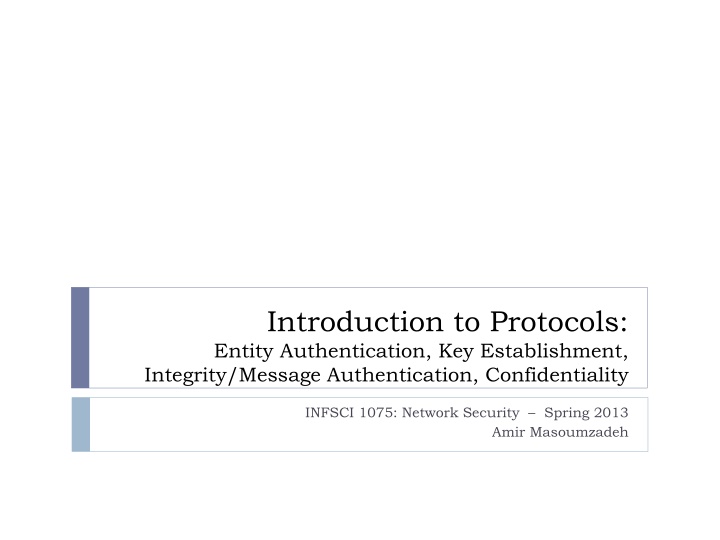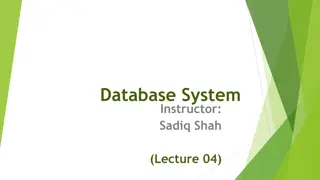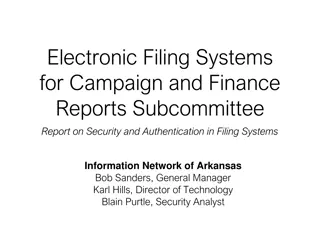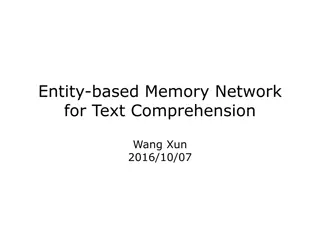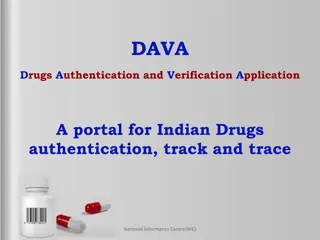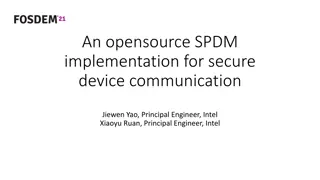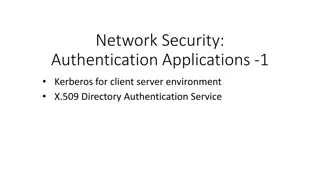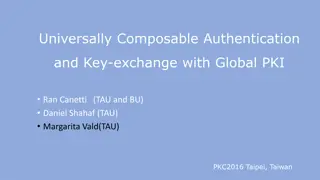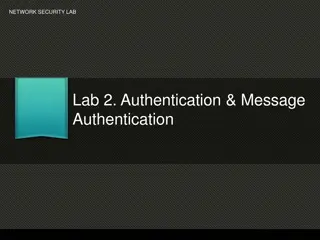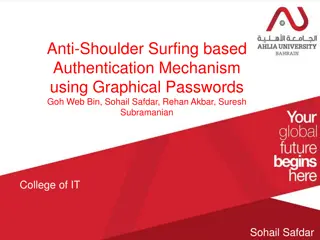Introduction to Entity Authentication and Key Establishment Protocols
Learn about entity authentication, key establishment, integrity, message authentication, and confidentiality in network security protocols. Explore the importance of user authentication and different security schemes to ensure data confidentiality and integrity.
Download Presentation

Please find below an Image/Link to download the presentation.
The content on the website is provided AS IS for your information and personal use only. It may not be sold, licensed, or shared on other websites without obtaining consent from the author.If you encounter any issues during the download, it is possible that the publisher has removed the file from their server.
You are allowed to download the files provided on this website for personal or commercial use, subject to the condition that they are used lawfully. All files are the property of their respective owners.
The content on the website is provided AS IS for your information and personal use only. It may not be sold, licensed, or shared on other websites without obtaining consent from the author.
E N D
Presentation Transcript
Introduction to Protocols: Entity Authentication, Key Establishment, Integrity/Message Authentication, Confidentiality INFSCI 1075: Network Security Spring 2013 Amir Masoumzadeh
Overview Authentication Weak entity authentication Strong entity authentication Authenticated Key Establishment Key establishment and management Public Key Infrastructure Message Confidentiality/Privacy Message Authentication 2
How Most Security Protocols Work? Step 1: Alice verifies her identity to Bob and vice-versa Bob Alice Step 2: Alice and Bob establish a shared secret (or a set of secrets) Step 3: Data communications with confidentiality and authentication 3
Authentication Schemes Some typical scenarios requiring electronic proof of identity Withdrawing money from an automatic teller machine Needs a PIN number Charging purchases to a credit card over telephones Needs the credit-card number and expiration date Remote login over a computer network Needs a login name and password Authenticated key establishment protocols 4
Such Techniques Are NOT Secure in General Passive attacks An eavesdropper can use the identifying information for his/her own purposes Credit card numbers and expiration dates are in plaintext! An ATM is somewhat more secure but someone monitoring the communication line could obtain all the information on the encoded strip as well as the PIN number Login and passwords are transmitted in plaintext (except say with SSH) Access to password files 5
What is User Authentication? Message authentication Involves a message and its integrity as well as where it originated (later) User authentication There is NO meaningful message Only a claim that This is me It is real-time Basis of access control & user accountability Also called identity verification Has two steps identification - specify identifier verification - bind entity (person) and identifier Formal Definition: Authentication is the procedure by which one party is assured of the identity of a second party involved in a protocol through corroborative evidence 6
Objectives of Authentication In the case of honest parties Alice and Bob, Alice should be successfully able to authenticate herself to Bob Bob should not be able to use the identification exchange with Alice to compromise her Oscar should not be able to impersonate Alice in an exchange with Bob, even though he is able to observe a large number of previous identification exchanges between Alice and Bob The above hold even if Oscar has successfully participated in an authentication scheme with Alice and/or Bob Oscar can simultaneously start multiple instances of the entity authentication protocol 7
Means of User Authentication What you know Something known by the party to be authenticated: PIN, Password, etc. What you have Something the party to be authenticated possesses: Smart card with a time variant password What you are or you do Something inherent to the party to be authenticated: Biometrics like fingerprints, voice, retinal patterns, etc. Comments: Authentication can be mutual or one way It should be computationally efficient 8
Weak Entity Authentication Features: Uses a fixed or time-invariant password, pin, or some other quantity The password or pin is shared between the user and the system Secret key scheme The User ID is the claim of identity The Password is the evidence in support of the claim Verification The user supplies the password to the system (reveals the password!) The system accepts this as a corroboration of the user s identity 9
Storing Passwords Obvious approach Store passwords in plaintext Set read and write access controls Superusers can determine the password If Oscar gets superuser access, the passwords are easily available Encrypted password files Password is stored as a hash value or encrypted value To verify identity, the system computes the hash of the supplied password and compares the entry in the stored file It is called encrypted even though most times it is a hash value that is stored * A hash function is any well-defined procedure or mathematical function that converts a large, possibly variable-sized amount of data into a small datum, usually a single integer that may serve as an index to an array 10
Attacks against Fixed Passwords Replay of fixed passwords People write down passwords If transmitted in plaintext (like telnet), Oscar can capture it on the link Exhaustive password search Oscar keeps trying each possible password Online attacks are rare (e.g., locks up after three trials) Offline attacks are more serious Password guessing and dictionary attacks Given access to a password file (encrypted), Oscar tests each password to see if there is a match Easy to do since the hash function is known To improve the probability of success, Oscar tries common words, proper names, lowercase strings etc. dictionary attacks 11
Preventive Measures Password rules Require users to have special characters, capital letters, etc. in their password Entropy = uncertainty in password Try to ensure that all passwords are equally likely Makes attacks more difficult Make the password verification process slow Verifying a few passwords is easy Comparing millions of passwords may be very time consuming Use pass phrases Increases the entropy without reducing human ability to remember Passphrases are stored as hash values and NOT truncated 12
Preventive Measures (cont.) Salting Augment passwords by a random string of t-bits before applying the hash function The hash value and the salt are both stored This increases the effort of a dictionary attack (by how much?) but not an exhaustive search Used in the UNIX operating system One-time passwords Major security threat is eavesdropping and replay Each password is used only once to prevent this problem System and user share a sequence of t passwords that are used one after the other Sequentially updated during authentication, the user and system exchange the password to be used the next time 13
Challenge-Response or Strong Entity Authentication Idea: Alice proves her identity to Bob by demonstrating knowledge of a secret known to be associated with her rather than revealing the secret itself to Bob during the protocol Use a Nonce* or some other time varying quantity as a challenge Use knowledge of the secret and the nonce in the response Oscar, who is monitoring the communications medium gains no useful information * Nonce: a number or bit string used only once, in security engineering 14
Nonce A nonce is a quantity that is not used for the same purpose more than once Examples: Sequence numbers Time stamps Random numbers Concatenation of a combination of these Typically serves to prevent otherwise undetectable replay 15
Challenge-Response Protocol Based on Shared Secret Keys Bob Alice Shared secret key kAB Generate a challenge x x Compute y = fkAB(x) y Compute y* = fkAB(x) Compare y* and y 16
Example Examples of functions DES encryption Computing xkAB mod p Used in smart cards and pass-code generators Secret Key kAB= 7; p = 17 Bob Alice Challenge = 3 Response = 11 Compute 37 mod 17 = 11 Check response 17
Assumptions of previous protocol Alice and Bob share a secret key The authentication protocol is unilateral The claim of identity is presumably completed earlier to the C-R protocol Possibly in cleartext Modified version of this protocol is specified in the ISO/IEC 9798-2 standard 18
Session Hijacking Alice identifies herself to Bob using a C-R protocol After the C-R protocol, Oscar may interject himself by spoofing Alice s address This is called session hijacking How do we prevent session hijacking? A secret key MUST be exchanged as part of the identification/authentication The secret key can be used to prevent spurious messages from being sent with the same address (how?) 19
The Key Problems Two communicating parties must share a secret key The keys should change frequently to prevent Oscar from getting too much of information about it The more ciphertext Oscar can have, the better the attack The more often you use the key, the better the attack Solution: use a hierarchy of keys 20
Authenticated Key Establishment (AKE) Establish a secret key with an entity whose identity has been verified Also called Authentication and Key Agreement (AKA) in some specific protocols Used in many applications Dial-up systems Kerberos 802.11i (WLANs) Cellular telephony 21
Key Establishment & Management Key Establishment A secure process by which a shared secret key becomes available to two or more parties for use later on for encryption, authentication, etc. Result of the protocol is the creation of a shared secret session key The session key is restricted for use for only a short time after which it is obliterated Key Management Set of processes and mechanisms which support key establishment and maintenance of ongoing key relationships such as replacing older keys, updating keys, storing keys, the roles of trusted third parties, etc. 22
Key Establishment Key Distribution or Transport One party chooses the secret key The secret key is securely transported to the other parties Key Agreement Two or more parties jointly establish a secret key by communicating over a public channel e.g., Diffie-Hellman Key Exchange Key Establishment Key Key Distribution Agreement Sometimes we make use of a Trusted Authority (TA), a Trusted Third party (TTP) or a Key Distribution Center (KDC) 23
Key Distribution Using Secret Keys Session Keys Used to encrypt communication between two end systems Used only for the duration of the logical connection (or for a fixed duration) Transported to communicating entities using a master key Master Key The key used for transporting session keys It is considered to be a long-term key Shared between communicating end-systems Usually it is physically delivered or manually installed 24
Why Session Keys? Limiting the availability of ciphertext The more the ciphertext, the more feasible the attack Limiting exposure If the key is compromised, only the data that has used the particular session key is compromised Avoiding long term storage of a number of keys If Alice needs to communicate with N possible users, she will use a session key only when the need arises Independence across communication sessions and applications Reduces the need to maintain state across sessions 25
Decentralized Key Distribution (1) Req||N1 Bob Alice (2) ekAB(ks||Req||IDBob||f(N1)||N2) Challenge (3) eks(f(N2)) kAB is the Master Key ks is the Session Key Response 26
Drawbacks A master key needs to be shared between all the nodes that need to communicate If there are N hosts we need N(N 1)/2 keys If we add a node to the network, all the other nodes must now create a shared master key with it Physical distribution of pairs of master keys is hard 27
Trusted Third Party Use a Trusted Third Party (TTP) often called a Key Distribution Center (KDC) This is a server based key distribution Each node or user shares a secret master key with the KDC A session key is generated by the KDC each time two nodes wish to communicate If Alice or Bob generate the session key, we call this a Key Translation Center or KTC Can also be used for distributing public keys and associated certificates - PKI later Drawbacks: The TTP must be trusted to keep the master keys secret The TTP may be a bottleneck for providing the session keys 28
Key Exchange Using Public Keys Why public keys? We do not wish to trust a third party Communications are created between entities that do not know each other a priori Example: Diffie-Hellman Key Exchange Protocol RSA for key exchange Problem: Man-in-the-Middle Attack 29
Key Exchange Using Public Keys (1) Request Bob Alice (2) IDB|| KUB (3) eKUB(IDA||ks) 30
Man-In-The-Middle Attack (1) Request Bob Alice (1) Request (2) Request (3) IDB||KUB (4) IDB||KUO (5) eKUO(ks||IDA) (6) eKUB(ks||IDA) Oscar y = eks(x) 31
Man-In-The-Middle Attack (cont.) Transmitting a session key by encrypting it with a public key is secure against passive attacks It is NOT secure against ACTIVE attacks Oscar can read and alter x without detection Public keys are not authenticated (so far) Applies also to the Diffie-Hellman Key Exchange Protocol 32
Distribution of Public Keys Public Announcement No authentication Easy to masquerade Example: PGP Publicly available Directory A TTP maintains an authenticated directory of names and associated public keys Each user registers his/her public key with the directory authority Keys can be updated Directories can be published periodically Authenticated communication is possible via MACs to access the directory electronically Records may be tampered Accessing the directory server could be a bottleneck 33
Using a Local Public Key Authority (4) Req||Time2 (1) Req||Time1 PK Auth (5) eKRAuth(KUA||Req||Time2) (2) eKRAuth(KUB||Req||Time1) Bob Alice (3) eKUb(IDA||N1) (6) eKUa(N1||N2) (7) eKUb(N2) 34
Using Public-Key Authority Provides stronger encryption The first four messages can be used infrequently to check if the public keys have changed Records might be manipulated at source (need third party trust) Bottleneck at the Authority 35
Public Key Certificates Idea: Bind the user s identity to his public key via his SSN, name, etc. Have a trusted authority to certify the binding Keep everything autonomous Anyone should be able to read the certificate Anyone should be able to verify the authenticity and currency of the certificate No one should be able to create a certificate except the trusted authority How? Use Digital Signatures 36
Requirements Anyone should be able to read a certificate to determine the identity and public key of the user The certificate must be tamperproof Only the Certificate Authority (CA) can change or update a certificate The certificate should have a verifiable lifetime 37
General Structure The User needs Identity: SSN, DOB, Name, E-mail address, URL etc. Private Key KRU Public Key KUU The certificate authority needs A secret signature algorithm sigKRAuth(x) A public verification algorithm verKUAuth(y) ID(User) KU(User) sigKRauth (IDU||KUU) 38
Public Key Distribution Using Certificates (4)IDB||KUB (1) IDA||KUA CA (5) C(B) = ? (2) C(A) = sigKRAuth(T1||IDA||KUA) Bob Alice (3) C(A) (6) C(B) Alice can decrypt C(B) Bob can decrypt C(A) Oscar cannot generate a certificate containing IDA||KUo or IDB||KUo 39
Advantages There is no serious bottleneck since certificates rest with the users and are public They can be downloaded and kept offline before an actual communication They cannot be forged and can be placed in public directories Hierarchical certification and directories can be used Certificates can be used for the validity of the lifetime 40
Public Key Infrastructure (PKI) Components that are necessary to securely distribute public keys Ideally consists of Certificates A repository for retrieving certificates A method for revoking certificates A method of evaluating a chain of certificates from public keys that are known and trusted in advance of the target public key 42
Message Confidentiality/Privacy Protection of transmitted data from unauthorized access Interception & release of information Clearly, the solution is encryption If the data is encrypted (say using a block cipher in an appropriate mode of operation) the contents are quite secure Traffic analysis Frequency of packets and dependence on time Source and destination networks Much harder to prevent 43
Traffic Confidentiality Attack Identification of communicating parties Frequency of communication Message pattern (length, quantity, etc.) Event correlation Security measures Link encryption Traffic padding Pad data units to be of fixed size Insert null messages 44
Message Authentication Authentication Assurance that a message is coming from an entity that supposedly sent it Protection against masquerade or fraud Integrity Assurance that the message has not been modified Contents insertion, deletion, transposition, etc. Sequence insertion, deletion, reordering Timing delay or replay Message Authentication = Authentication + Integrity 45
Message Authentication How do we know whether or not a message is coming from the claimed source? How do we know that the message has not been modified in between? There must be an authenticator to verify the authenticity of the message Message encryption Hash functions Message authentication code 46
Secret Key Based Encryption for Message Authentication Insecure channel y Alice Bob x Encrypt Decrypt x k k Alice and Bob share a key k Nobody else is aware of the key k If a message is received by Bob that can be decrypted using the key k, the message MUST have originated at Alice 47
Drawbacks of Simple Encryption for Message Authentication If the ciphertext y can be anything (e.g. a block of 64 bits that look random), Oscar can send spurious or meaningless messages to Bob Bob cannot automatically say whether Alice sent the meaningless messages Need some structure in the plaintext that can be used to determine spurious messages The structure MUST be secure Oscar can replay the messages sent by Alice without being detected We look at this later 48
General Idea of Using a Function for Message Authentication Generate a function or fingerprint of the message Store it securely if the data is in an insecure place Transmit it securely if the data is transmitted over an insecure channel If the data gets altered Hopefully the altered data will NOT have the same fingerprint as the original data If the fingerprint is secure, we can detect the modification 49
A Simple Method for Securing the Fingerprint Append it to the message Encrypt the message and the appended function A random sequence of bits will not have the properties that the above ciphertext has Advantages Using layered communications protocols automatically creates a form of authentication because of the structure 50
